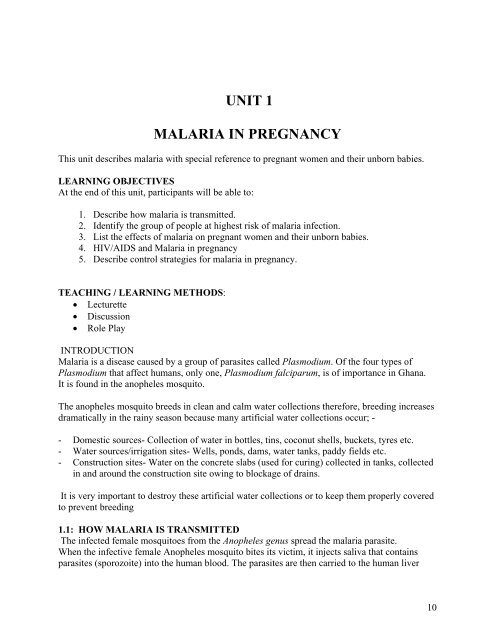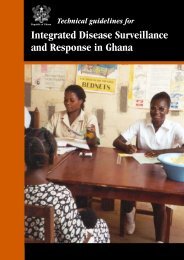Training Manual for Preventive Malaria - Ministry of Health
Training Manual for Preventive Malaria - Ministry of Health
Training Manual for Preventive Malaria - Ministry of Health
Create successful ePaper yourself
Turn your PDF publications into a flip-book with our unique Google optimized e-Paper software.
UNIT 1<br />
MALARIA IN PREGNANCY<br />
This unit describes malaria with special reference to pregnant women and their unborn babies.<br />
LEARNING OBJECTIVES<br />
At the end <strong>of</strong> this unit, participants will be able to:<br />
1. Describe how malaria is transmitted.<br />
2. Identify the group <strong>of</strong> people at highest risk <strong>of</strong> malaria infection.<br />
3. List the effects <strong>of</strong> malaria on pregnant women and their unborn babies.<br />
4. HIV/AIDS and <strong>Malaria</strong> in pregnancy<br />
5. Describe control strategies <strong>for</strong> malaria in pregnancy.<br />
TEACHING / LEARNING METHODS:<br />
• Lecturette<br />
• Discussion<br />
• Role Play<br />
INTRODUCTION<br />
<strong>Malaria</strong> is a disease caused by a group <strong>of</strong> parasites called Plasmodium. Of the four types <strong>of</strong><br />
Plasmodium that affect humans, only one, Plasmodium falciparum, is <strong>of</strong> importance in Ghana.<br />
It is found in the anopheles mosquito.<br />
The anopheles mosquito breeds in clean and calm water collections there<strong>for</strong>e, breeding increases<br />
dramatically in the rainy season because many artificial water collections occur; -<br />
- Domestic sources- Collection <strong>of</strong> water in bottles, tins, coconut shells, buckets, tyres etc.<br />
- Water sources/irrigation sites- Wells, ponds, dams, water tanks, paddy fields etc.<br />
- Construction sites- Water on the concrete slabs (used <strong>for</strong> curing) collected in tanks, collected<br />
in and around the construction site owing to blockage <strong>of</strong> drains.<br />
It is very important to destroy these artificial water collections or to keep them properly covered<br />
to prevent breeding<br />
1.1: HOW MALARIA IS TRANSMITTED<br />
The infected female mosquitoes from the Anopheles genus spread the malaria parasite.<br />
When the infective female Anopheles mosquito bites its victim, it injects saliva that contains<br />
parasites (sporozoite) into the human blood. The parasites are then carried to the human liver<br />
10















